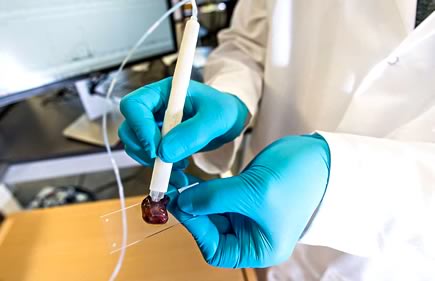Recent News & Events
"The MasSpec Pen" Can Detect Cancerous Tissue in Seconds During Surgery
05

Current Cancer Diagnosis Process
Frozen Section Analysis is the current method that doctors use to diagnose cancers and determine the boundary between normal and cancerous tissues during surgery. It involves cutting a piece of tissue, freezing and staining it, and having a pathologist inspect the sample. This state-of-the-art process takes at least 30 minutes, which extends surgical operations and increases the risk of infection and negative anesthesia-related side effects for patients.
However, the results aren't always accurate because freezing tissue can change its structure. Also, the tumor boundary is the most difficult place to tell whether the tissue is cancerous or benign. Removing too much benign tissue can affect organ function, so surgeons have to constantly make judgment calls about where to cut tissue for samples. For this reason, breast cancer patients often go through two or three surgeries before the cancer is completely gone.
The MasSpec Pen
UT Austin engineers and scientists want to turn these problems upside down. They developed the MasSpec Pen, which produces rapid, nondestructive tissue analysis to diagnose cancer. The pen-shaped device relies on mass spectrometers, which are large machines that use mass and trajectories through magnetic or electric fields to identify molecules. The handheld instrument attaches to the mass spectrometer, which is currently the size of a copy machine from the 1990s.
To use the pen, the surgeon holds it against the piece of tissue. It releases a tiny drop of water, and any water-soluble molecules naturally dissolve, such as cancer-specific metabolites. Then, the pen pumps the droplet through a tube to the mass spectrometer. The machine provides information about every molecule in the sample. Lasso, a statistical classifier algorithm, analyzes the information. In tests, the UT Austin team was able to use this info to recognize cancer biomarkers based on mass-to-charge ratios.
The entire process takes just 10 seconds, a huge time reduction from the current detection method. It also means that surgeons can test tissue before they cut, preserving healthy tissue because there's no evidence of tissue destruction using the device.
Human Cancer Tissue Test Results
The UT Austin team tested the MasSpec Pen on 20 human cancer tissue sections and 253 cancerous and normal human tissue samples from the breasts, lungs, ovaries and thyroids. Using ex vivo molecular analysis, they could predict cancer with high sensitivity at 96.4 percent accuracy and with specificity at 96.2 percent accuracy. In tumor-bearing mice, the team demonstrated that the instrument is suitable for in vivo cancer diagnosis without harming the tissue or causing stress to the animal.
Plans for a Pilot Study
Livia Eberlin, UT Austin's associate professor of chemistry and device development leader, plans to start testing the handheld mass spectrometry pen in oncologic surgeries in 2018. She wants surgeons to test the capabilities of the device so that she can compare the results with current detection techniques. In addition, she envisions developing a cheaper, smaller mass spectrometer that can truly make the MasSpec Pen portable for surgical rooms.

Comments (1)
Subhash Pardeshi
Heartiest Congratulations to the team of researchers.
reply